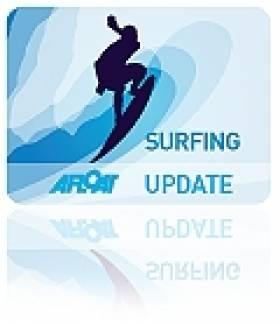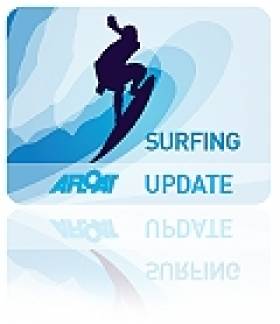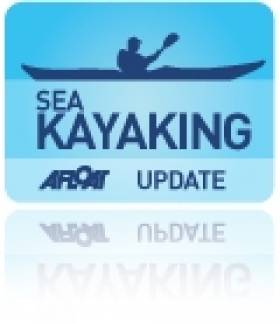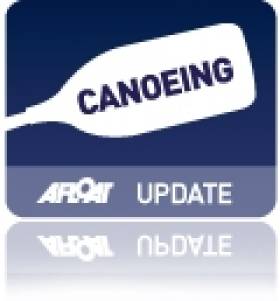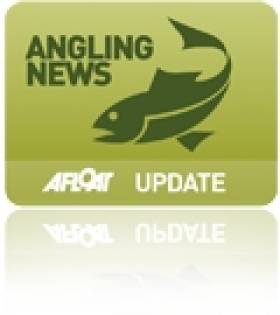Displaying items by tag: record
Cornish Surfer Rides Ireland's Record Biggest Wave
#SURFING - British surfer Jayce Robinson wasn't about to let the largest wave ever recorded off Ireland's shores go by without giving it a shot.
And as Sky News Online reports, he was captured doing exactly that on Tuesday afternoon.
The Cornish surfing pro told the website: "It was definitely the biggest barrell I've ever surfed.
"I was a little nervous but I didn't have time to think about it - it's almost like a car crash, you don't know what's happening."
Robinson rode the giant wave for 20 seconds before the lip crashed down and knocked him off his board.
His surfing partner Lyndon Wake, who towed him to the swell at Mullaghmore Head, said: "It's always a worst case scenario when your tow partner wipes out. Lucky he managed to come out the other side OK."
As previously reported on Afloat.ie, storm force winds off the coast of Donegal produced monster rollers of over 20 metres (over 60 feet) in height detected in Donegal Bay.
Mullaghmore Head will once again welcome the world's top big wave surfers for the second annual Tow-In Surf Session in the New Year.
Public Needed to Help Record Whale and Dolphin Strandings in UK
#MARINE WILDLIFE - Some 46 reports of stranded whales and dolphins in Northern Ireland are among the thousands recorded across the UK over the last six years, according to BBC News.
A new study co-ordinated by the Zoological Socoety of London (ZSL) shows that some 3,500 cetaceans were stranded on the British coastline between 2005 and 2010.
Though year-on-year figures have fallen overall, is presumed that many more strandings have gone undetected.
Many were found to have died of disease or starvation – particular harbour dolphins.
But human activity such as fishing, shipping and chemical pollution also poses a significant threat to marine wildlife in the waters around the British Isles, said Rob Deaville of the ZSL.
The public is being encouraged to report stranded marine mammals to help create a more accurate picture.
BBC News has more on the story HERE.
Van Gelderen Claims Irish Speed Sailing Title for 2011
#WINDSURFING - Oisín van Gelderen is all but confirmed as Irish Speed Sailing Champion for the second year running.
His national record speed (44.23 knots by 5x10 second average and 43.96 knots over 500m) puts him far ahead of his nearest competition in the rankings.
But his competitive spirit would not let him rest on his laurels.
"Ever since setting that record in February, I have been trying to beat it," he said, "and we had a really good day on Thursday in Dungarvan."
Though he did not beat his averages, he did set a new Irish record for peak speed at 47.89 knots (verification pending).
Van Gelderen dedicated his previous national title win to to the memory of Surfdock founder Alan Harris and Irish 500m speed record holder John Kenny, who both passed away in 2010.
Meanwhile, his Surfdock teammate Noelle Doran has taken the women's title for 2011 with a very impressive set of times for the year.
Her Irish women's peak record of 38.17 knots was complemented by third overall place for 2011 by 5x10 second average and first in the world over 500m.
"I'm so delighted for her," said Van Gelderen. "She had a nasty injury a few years ago, where she dislocated her hip while windsurfing. The resulting nerve damage put a stop to her competing in Waves and Freestyle, where she had multiple national titles."
Record Wave Detected By Offshore Weather Buoy
#WAVE – The biggest ever wave in Irish waters was recorded yesterday when storm force winds off the Coast of Donegal produced monster rollers of over 20 metres (over 60 feet) in height off the Northwest tip of Ireland. At least two giant waves put meterologists on alert yesterday prompting the Coastguard to issue a weather warning.
The 20.4 metre wave was detected in Donegal Bay by the M4 weather buoy, according to Met Eireann. The wave was recorded at 2pm yesterday. (Tuesday 13th December 2011),
Meteorologists said sea conditions, about 60 miles out to sea, were the most serious they had ever experienced. The Irish Coastguard said they had recorded winds of up to 140km per hour off the north-western coast yesterday and issued a warning.
The M4 weather buoy is located 75km north of Belmullet on the north west coast of Ireland. The M4 buoy forms part of the Irish Weather Buoy Network which began in 2000 and is funded by the Department of Transport, Tourism and Sport and run by the Marine Institute in collaboration with Met Eireann and the UKMO.
"This is the largest wave measured on the Weather buoy network to date. However, these recordings are a result of the next generation buoy which was deployed last year. Historically, only the significant wave height could be measured by the older buoys, where heights of between 10 and 13 meters were typically recorded around the coast during winter. The next generation buoys allow us to record and transmit both significant wave height and maximum wave heights as part of our hourly observations," explains Sheena Fennell, oceanographer with the Marine Institute.
Over the last number of years the network has been going through a transitional phase replacing the older models with next generation buoys supplied by Fugro Oceanor. The combination of high quality real time measurements coming from the offshore buoys and coastal systems, coupled with the mathematical forecasting models, is extending the well proven ability of scientists and engineers to accurately forecast the atmospheric conditions and sea state of the ocean.
"With the development in technology we are now able to record maximum wave heights which the older style buoys couldn't do. This parameter will form an important part of forecasting as we move forward." Sheena Fennell further said.
Met Eireann say the stormy conditions will gradually ease off tonight, but then frost and icy patches will develop. However it will remain very windy for a time early tonight, with severe southwest to west gales.
First Sighting of a Dolphin in an Irish Lake
#MARINE WILDLIFE - The first recorded sighting of a dolphin in an Irish lake has been reported by the Irish Whale and Dolphin Group (IWDG), according to The Irish Times.
The dolphin was spotted in Lough Hyne, a saltwater lake near Baltimore in Co Cork by Skibbereen-based kayaking instructor Jim Kennedy, who filmed it over a number of days.
"To the best of my knowledge, and I’m open to correction, this is the first validated record of a cetacean using an Irish lake," said the IWDG's Pádraig Whooley.
Though there have been no further sightings since then, there is nothing to indicate that the dolphin has yet left the lough for the open sea.
As previously reported on Afloat.ie, Lough Hyne was also recently visited by a 13-metre fin whale that was sadly found beached in stormy conditions on the Sligo coast this week.
The Irish Times has more on the story HERE.
Whale Carcass Battered by Strong Sea Gales in Sligo
#MARINE WILDLIFE - The Irish Independent reports on the carcass of a whale that was strewn on a beach in Co Sligo after it was swept into rocks by Monday's gale-force winds.
The 13-metre fin whale had been seen recently on a number of occasions in Lough Hyne, a saltwater lake near Baltimore in Co Cork.
On Monday it was spotted at Raughley in the north of Sligo, where it was found beached by Jimmy and Viera Stupakova after the treacherous conditions of the early part of this week.
The find marks the fifth recorded stranding of the species in Irish waters, and the first validated record of a fin whale in Co Sligo, according to OutdoorCommunity.ie.
It is not yet clear how the juvenile met its end, though initial investigations point to the whale not being long dead.
The Irish Independent has more on the story, including video, HERE.
Welsh Kayaker Sets New Irish Sea Crossing Record
According to Canoe & Kayak, last Saturday 2 October Anglesey man John Willacy crossed from Soldier's Point in Holyhead to Howth in Dublin - a distance of 55.8 nautical miles - in 11 hours 19 minutes and 59 seconds.
It's not the first open sea kayaking record set by Willacy, who last year broke the record for circumnavigation of the Isle of Man in 12 hours 38 minutes.
Avoca Produces Record Sea Trout
Denis O'Toole has spoken of his amazement at catching a record 16-pound sea trout from the Acova River in Co Wicklow.
The angling hobbyist and professional fly dresser told the Bray People how he had spent the day fishing with a friend in what has been described as 'the most polluted river in Europe' when he spotted the monster, and decided to take up the challenge.
"I went down to the pool where I had previously seen the fish move," he said. "I put on a 1 1/2 inch aluminium tube with a salar single hook (with the barb squeezed down) and started at the head of the pool.
"On my fourth cast while stripping the fly back he hit it with a bang and all hell broke loose; all I could see was white foam on the water through the inky darkness. I thought I had hooked Free Willy."
O'Toole continued: "He was lying in only three feet of water when he took and in total the fight lasted 20 minutes. My fishing partner, Dean Kennedy, netted the fish. He was then carefully weighed and measured and released back to spawn to produce more 16 lb'ers."
The Bray People has more on the story HERE.
Big Weekend for Ireland's Canoeists in Balkans
Eoin Rheinisch made a good start in the K1 qualification round at the Canoe Slalom World Cup in Slovenia.
The Kildare native - who is recovering from a shoulder operation - finished 10th in the heats, qualifying for yesterday's semi-finals where he finished in 28th place.
The Irish Times reports that he described the performance as encouraging.
“I enjoyed myself today and that was my goal,” he said.
In other action from Slovenia, Hannah Craig failed make the semi-final in the women’s K1, while Patrick Hynes and Ciaran Heurteau missed out in the men’s K1.
Meanwhile in Serbia, Salmon Leap's Jenny Egan set a new Irish women's record of 1m 55.9 sec in the 500m semis at the European Sprint Canoe Championships in Belgrade, the Evening Herald reports.
She went on to finish ninth in both the 5,000m final annd 200m B final.
Fellow Salmon Leap member Barry Watkins placed fourth in the 500m B final and eighth in the 1,000m B final.
Killybegs Angler Catches 11lb Sea Trout
The Donegal Democrat reports that a Killybegs angler landed a record-sized sea trout at the Erne esturary in Ballyshannon recently.
John Cunningham, 48, battled for 10 minutes with the 11lb 1oz monster trout before seizing his quarry. He described the experience as "good fun".
The fish was more than five times the average caught in Irish, and beat the previous area record by some 3lbs.
Now returned waters of the Erne, the sea trout will be officially branded a specimen fish by the Irish Specimen Fish Committee.


























